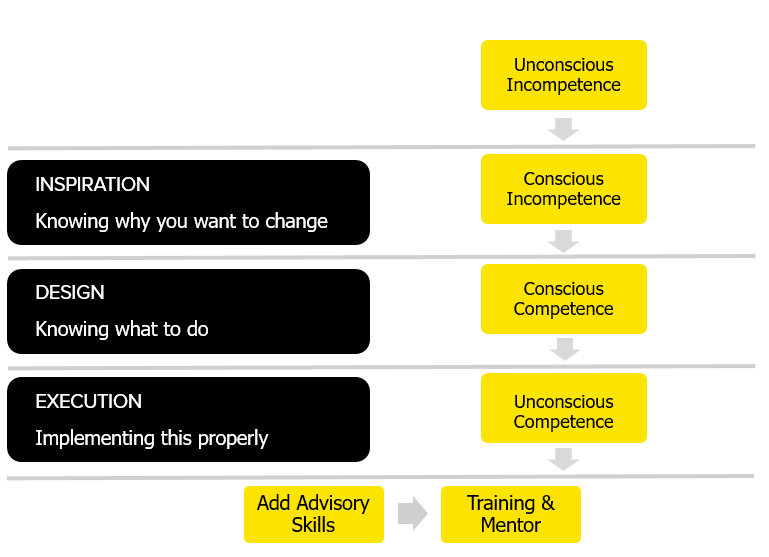
Ideas Are Worthless, Execution is Priceless
by Jacob Aldridge, International Business Advisor
The typical business owner has a million great ideas before breakfast – even more, if you’re intermittent fasting, so don’t eat until midday. But how many actually get implemented, to benefit your team and your commercial vision?
Edison told us that success was 1% inspiration and 99% perspiration, and this is even more true in a world where a bright idea can be shared, loved, and forgotten in the blink of a social-media eye: Ideas are Worthless. Execution is Priceless.
So why do so many small and medium-sized businesses fail to execute on their great ideas? It’s because we fight against the necessary step between the two – strategic planning.
The Layers of Learning
My clients use a consistent framework for understanding strategic (and operational) capability in their teams.
For most skills in most people, we track these 3 Levels of Learning – Inspiration (Knowing WHY a skill is important), Design (Being educated about WHAT is involved), and Execution (actually demonstrating HOW that skill is implemented). Additional levels, such as being able to train in skill, can follow.

As you can see, this maps the development of skill from “Unconscious Incompetence”, when you don’t know what you don’t know like a toddler behind the wheel of a car, down through improved awareness until ultimately “Unconscious Competence” where you can effectively perform a task without much efforts, like your morning drive to the office.
This also applies to your great strategic ideas.
Too often, we jump from INSPIRATION on a new idea to immediately attempting EXECUTION. We jump over Strategic DESIGN – taking the time to fully understand the new concept, including training and education if required, and planning implementation.
Sound Familiar
Have you ever been to an event, or listened to a podcast, and thought “That’s a great idea for my business”? You share it with your leadership team, send off some emails … and then it languishes, before being overrun by the next inspiration you glean from TikTok.
Whether it was a good idea or not, you just wasted everyone’s time and energy. Worse still, you may be building a precedent where your team know they are safe to ignore your ideas – because they never last.
Entrepreneurs move fast because time is money. We don’t want to be delayed by research and planning. But here’s the key for you: Slow is smooth. And smooth is fast.
Said differently, in business sometimes you need to slow down to speed up. Taking time to build your team’s capability, and agreeing on a roadmap to success, pays enormous dividends on your ideas.
Often, it will demonstrate that the idea was not so great – that the return doesn’t warrant the investment.
For your best ideas, proper planning will lead to faster implementation, and a change process that your team support (and even deliver without your constant supervision).
Link to Strategic Planning

One reason many business owners fail to implement the strategic plans we’ve discussed over the past two months is that they are easily distracted by the “squirrels” of bright ideas.
When you document your capacity plan, you can share it with your team and have them take responsibility for developing the skills required to turn ideas into reality.
You will demonstrate your long-term perspective and strategic foresight, giving your team, clients, and suppliers confidence in your expertise as a business owner – far greater than having a reputation for inspiration that is never more than a flash in the pan.
Actions
- Are you a squirrel hunter? Do you create the time to plan your strategy, or are you constantly distracted by the next big idea?
- Do your team take responsibility? There are many reasons why your team may not step up, but in a strategic space nobody will ever take responsibility for long-term projects if you keep interrupting them.
- How you remember your ideas? Linked to the strategic capacity plan we discussed previously, how are you recording great ideas for the future – so they are not lost, but also don’t interrupt the current priorities of your team.
So how much time do you – and your team – need to spend on improving your business ideas? Next month I will talk about the various phases that private businesses go through, from the solopreneur doing everything to the larger enterprise where every key function is run by a team much smarter than you!



